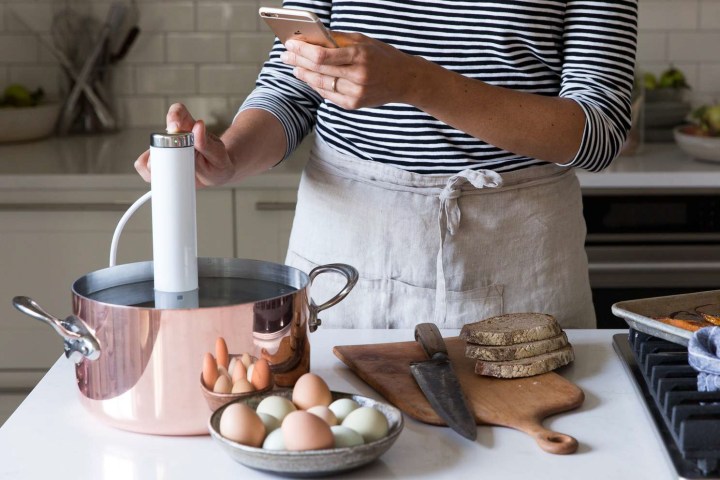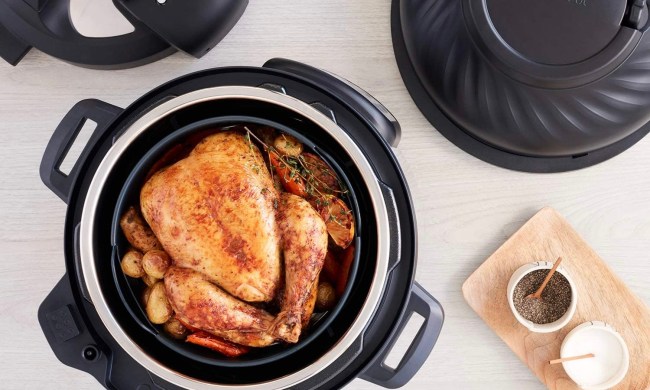Sous vide is a pleasantly simple yet sophisticated cooking method: You heat up water with a specialized device, and use that water to cook food sealed in a bag. That same simple process is ideal when it comes to even the most ambitious cooking projects, such as getting prime cuts of meat to the perfect temperature without danger of burning them. It’s not surprising that people are starting experimenting more with sous vide in their homes — and there are home-friendly sous vide machines to help out.
Two of the most popular models are the Joule and the Anova cookers. Both operate on the same principle: You hook them to the side of your pot, and they cycle water past a heater to ensure precise water heating for you so you can get the best results. Let’s break down the details of each machine to find out which is a better buy for your kitchen.
Design and models

Right upfront, we come across one of the most important differences between these sous vide devices. Joule only has one primary device, a small, lightweight model, only around 11 inches tall and a bit over a pound. You have a choice between stainless steel and white polycarbonate, but that’s really the only option here.
Anova, meanwhile, offers three different models with varying specs. In the middle is the basic Precision Cooker with Wi-Fi (currently out of stock on Avida’s website, but still available for sale elsewhere…for now). It’s significantly larger than the Joule at about 15 inches high and over two pounds. On the lighter side, there’s the Anova Nano, a smaller model for smaller projects at 13 inches higher and around 1.5 pounds. It’s a cheaper, Bluetooth-only model. Then there’s the larger Pro model, really aimed at professional kitchens, measuring almost 14 inches high and weighing around 2.8 pounds, and with a lot more power than the smaller devices.
There’s no easy winner here, but it is nice that Anova gives you several different options to work with, while you only have one choice with Joule.
Temperatures

The Joule can reach up to 208 degrees Fahrenheit, with a maximum container (or “bath”) size of around 10 gallons.
Anova, meanwhile, has power and temperature ranges based on its models:
- The Nano version can reach up to 197 degrees Fahrenheit for up to 5 gallons.
- The standard version can reach 210 degrees Fahrenheit with a tank capacity of 4 to 5 gallons.
- The Pro version can reach 197 degrees Fahrenheit for up to around 26 gallons — and the Pro model is the only one designed for around-the-clock work.
Performance

Sous vide cookers can only heat as fast as their wattage allows. A higher wattage means that you don’t have to wait as long for your water to come to the right temperature. This may not be the most important aspect of cooking for everyone, but saving time is usually an important goal — so looking at wattage can tell us a lot.
The Joule comes with an impressive 1100 watts of power, and is precise to 0.2 degrees Fahrenheit. That leads to excellent heating speed and accuracy, which in turn leads to great results in the kitchen.
Anova, by contrast, has trouble reaching these numbers. The standard model is only 800 watts, so it will take considerably longer to heat water. The Nano version only has 750 watts. It’s not until the Pro version, which has 1200 watts of power, where the Anova becomes competitive compared to Joule’s performance.
This is one area where the Joule is clearly the superior option, unless you want to splurge for the expensive Anova Pro model.
App features

Both cookers come with accompanying apps for controls, and in many ways these apps are similar. They both offer hundreds of different recipes for you to try with step-by-step instructions. They both guide you through cooking processes you may not be familiar with, allowing you to set very specific temperatures and get alerts via Bluetooth or Wi-Fi.
However, the Joule app pulls ahead in a couple different ways. While Anova’s app includes some video tutorials, Joule goes a step further and gives you a “visual doneness” option, where you can see how done the meat will look if you choose a certain setting, ideal for first getting started with sous vide. Joule also has voice control options via voice assistants like Amazon Alexa that you can use if your hands are full.
Pricing

The Joule cooker is available for $200 with stainless steel, and $180 for the white polycarbonate version.
The Anova cooker starts at $100 for the Nano version, at $130 the midrange model, and at $400 for the Pro version.
As you can see, it’s easier to save money by choosing Anova options, making these better choices for a very strict budget. However, you do give up power and heating speed by choosing these lower priced options.
Conclusion
For home use, the Joule is the ideal mixture of power and pricing, and its small size is another significant bonus, making it our top recommendation. If you are planning for only intermittent sous vide sessions on a budget, the Anova Nano model may be a better option for you — and likewise, the Anova Pro is designed specifically for pro kitchens or food carts, and really shines if you plan on making larger batches.



